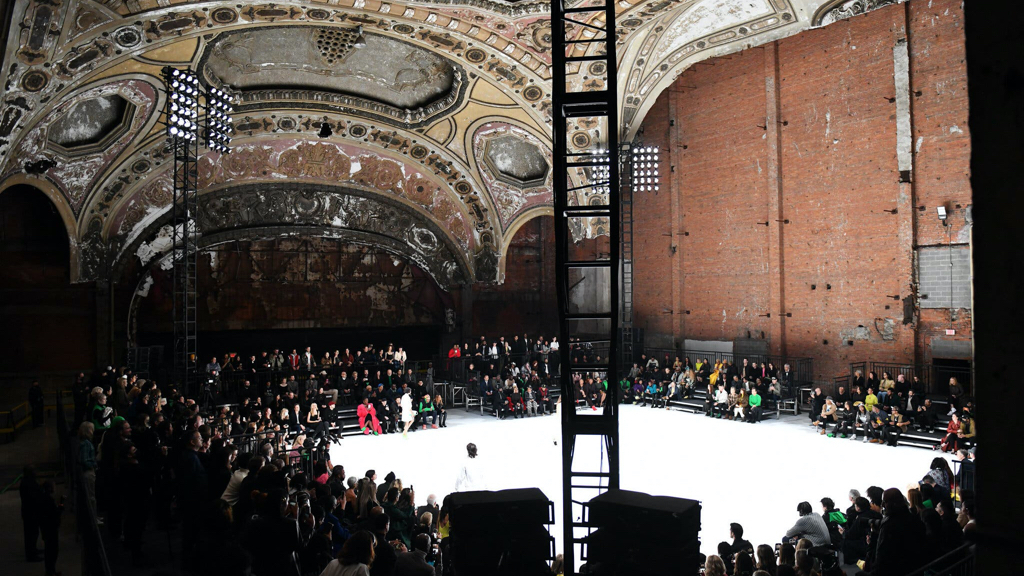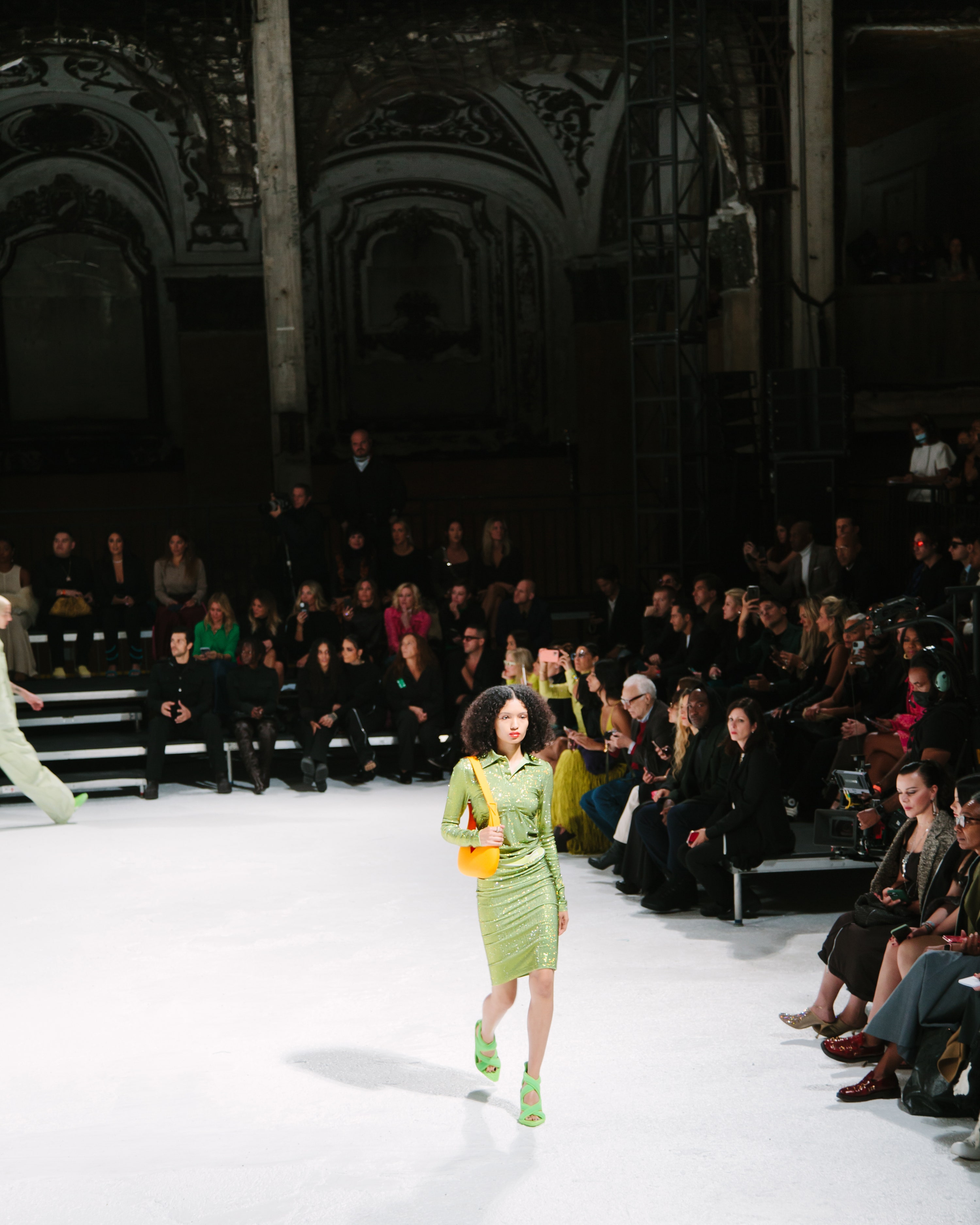
Mary Kate and Ashley
November 22, 2021
Bottega Veneta Salon 03 Detroit took place on October 21, 2021 inside the main hall of the Michigan Building, which formerly functioned as the Michigan Theatre and currently functions almost full time as a parking garage Downtown. Before the event actually happened, there was talk throughout the city that it was coming. It seemed to remain on a relatively hush hush basis though, until the few days came that the operation swooped in like a storm, utilizing a lot of local talent, renting out the Shinola Hotel, renting out the Magic Stick, opening a pop-up in an old firehouse in Corktown and then leaving. The speed at which a fashion company like Bottega Veneta can set up an event like that in a city like Detroit, where time moves so much slower, was eye opening and even disorienting; the contemporary pace of spectacular capitalism is wild.1

As the story goes, former creative director of Bottega Veneta, Daniel Lee, has an affinity towards techno music and because of that, has an interest in the city of Detroit. He has also mentioned the parallels between Detroit and his hometown of Leeds which is an “industrial heartland” of England.2 Additionally, Lee and the Bottega’s success seems to benefit heavily from representation by Black celebrity household names like Mary J. Blige and Lil’ Kim, each of whom attended the event in person. With Detroit being known as the birthplace of techno music, a capital of early industrial movements and a city with a majority Black population, the brand was naturally prompted to seek out the opportunity to premiere a collection here.


The usual fashion centers of the world occasionally take a backseat when designers become curious and exploratory, asking what would it mean to exhibit this work here? How would the work be read if it were premiered there? Of course, within the world of art, music, fashion, design, anything really, things can be much more interesting when the context of place is considered in relation to the content. It has been said that the styles of Bottega Veneta reflect the aesthetics of techno music culture...well, at least for those who like to rave in a $400 pair of socks... But, despite the actual pieces being wildly inaccessible to most of the people who live in places where raves are free and thrown in abandoned industrial plants, there is something to be said for the strong colors and seemingly sturdy gear that could probably hold up in a post-apocalyptic reality.
Why not bring the work directly into a world that animates it as the designer intended? There are so many other instances where brands set up shop in places that don’t regularly benefit from the riches of the fashion world, using them as backdrops to entertain their audience and construct a story around the pieces on display. In June of 2021, Dior held their Cruise 2022 show at the Panathenaic Stadium (built 330 bce) in Athens, Greece.3 On July 5, 2019 Dolce & Gabbana held its Alta Moda fashion show at the Temple of Concordia (built 440-430 BC) in Agrigento, Italy on the island of Sicily.4 In July 2016 for its 90th anniversary, Fendi held their couture show Legends and Fairytales at the Trevi Fountain (built 1732) in Rome, Italy. 5
Just as these cases involving Dior, Dolce & Gabbana, Fendi and others, “fashion brands are under a microscope when it comes to issues of race and class, and it was a ballsy move for a European luxury brand to sweep into a city with a history as complex as Detroit’s and make the case for strong synergy.”6 When Gucci requested access to use the Acropolis in a runway show planned for June 2017, they were denied by Greece’s Central Archaeological Council (KAS) who stated: “The unique cultural character of the Acropolis monuments is inconsistent with this sort of event...We have a duty to defend the importance of [the Acropolis]…a global symbol of democracy and freedom.”7 An important conversation that has been on the minds of skeptics remains the question of whether these efforts to take over these kinds of spaces are mutually advantageous. It is clear that taking the work directly to the source of inspiration can contribute to the potency of its read, and it may even act as an homage to the place itself. In the end though, these places are often left empty handed while the powerhouses of the fashion world move on to the next show. But, of course, these critiques can be dangerous. There is a careful balancing act that happens when you want to have outstanding cultural events in town while also not wanting to be just used and then forgotten again.
What does it mean for a city like Detroit to benefit from hosting a show by a fashion brand like Bottega Veneta? Well, the Bottega Veneta Salon 03 runway show and pop-up required a lot of local talent. Working closely with local artists, builders, musicians, etc. contributed to the feeling of intimacy on a number of levels including heavy promotion and documentation from the perspectives of the local participants and attendees who shared their personal point of view through social media. Efforts like this, as well as the initiative to open a store in the city that stocks pieces by Bottega Veneta amongst work from many local artists, positioned the brand as a caring force within the community, cultivating trust where it otherwise wouldn’t be. Amani Olu of Olu & Company was one of the central figures assisting with the coordination of this event. They were an essential component to accessing the local talent in the city, which is relatively underground and tough to find without a connecting source. Information about local contributions to the event comes from intermittent instagram posts and hearsay, but it is understood that local artist Skyylar Taylor of Altered States was the professional make-up artist of the special guests, Moodymann scored the runway show with a post-show sound and light installation by Carl Craig, music for the after party was organized by the local music venue Spotlite, the records that are being sold in the record shop from Underground Music Academy were curated by Jonah Silverstein of Detroit Sound Conservancy, local artists Chris Schanck and Aratani Fay have furniture featured in the shop, local collective Hamtramck Ceramck as well as artists Sophie Esner and Ruben Cardenas have a collection of works for sale at the shop, there are textiles by Substudio and furnishings by Donut Shop too. The world that these artists were invited to partake in for this event can end up being beneficial for their career. Many notable publications like The New York Times, GQ or the Wall Street Journal covered this event and pop-up in Detroit and there was some documentation that acknowledges the labor of the local participants, but one can’t help but imagine what even more thorough press recognition might do for the careers of these locals. That is one of the ways that the phrase mutually advantageous could exist in this context; more direct and wide-scale recognition of the talent and laborers that were utilized to make this event happen.
That being said, it does feel exciting for Detroit to be on the radar of such an internationally relevant brand. It is invigorating for the local community to be able to experience an event like this in person. The pieces on display were from the top tier luxury Italian fashion world, giving a very small select group of locals, but locals nonetheless, a chance to partake in appreciation of high quality design in their own backyards. In line with Bottega Veneta’s ongoing vibe, the work featured on the runway in Detroit oscillated from 90’s rave-culture-ware to science fiction post-apocalyptic-ware to night on the town-ware to comfy-home-ware donning androngenous models styled through the lens of a funky British filter. The dynamic generated by the variety of styles presented here refreshingly contrasted with the setting of the abandoned Michigan Theatre, allowing the space to again embody its original agency as a beautiful place to experience and appreciate beautiful things.
To visit the Bottega Veneta Firehouse, it is located at 1201 Bagley St and is open with varying hours that can be found online.






1. Richard Gilman-Opalsky, Spectacular Capitalism: Guy Debord and the Practice of Radical Philosophy. (London, NYC, Port Watson: Minor Compositions, 2011), https://www.minorcompositions.info/wp-content/uploads/2011/06/spectacularcapitalism-web.pdf
2. Rachel Tashjian, “Bottega Veneta Goes Industrial in Detroit”, GQ, October 22, 2021, https://www.gq.com/story/bottega-veneta-detroit-interview
3. Bella Kontogianni, “Stunning Dior Fashion Show Held at Athens Panathenaic Stadium”, Greek Reporter, June 18, 2021, https://greekreporter.com/2021/06/18/dior-fashion-show-athens-panathenaic-stadium/
4. Mary Elizabeth Androitis, “Thanks to Dolce & Gabbana, Tourists Can Enter This Ancient Temple for the Rest of the Summer”, Architectural Digest, July 12, 2019, https://www.architecturaldigest.com/story/thanks-to-dolce-and-gabbana-tourists-can-enter-this-ancient-temple-for-the-rest-of-the-summer
5. Lauren Alexis Fisher, “Inside Fendi’s Breathtaking Couture Show at Rome’s Trevi Fountain”, Harpers Bazaar, July 8, 2016, https://www.harpersbazaar.com/fashion/fashion-week/news/a16573/fendi-couture-show-at-trevi-fountain/
6. “Bottega Veneta Goes Industrial in Detroit”
7. Perwana Nazif, “Greece Rejects Gucci’s Request to Use Ancient Site for Runway Show”, Art Net, February 17, 2017, https://news.artnet.com/art-world/gucci-acropolis-runway-864644